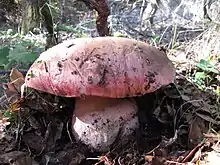Rubroboletus eastwoodiae
Rubroboletus eastwoodiae, or satan's bolete,[2] is a toxic basidiomycete fungus of the bolete family. It occurs on the West Coast of the United States. It is closely related to Rubroboletus pulcherrimus.
| Rubroboletus eastwoodiae | |
|---|---|
 | |
| Scientific classification | |
| Domain: | Eukaryota |
| Kingdom: | Fungi |
| Division: | Basidiomycota |
| Class: | Agaricomycetes |
| Order: | Boletales |
| Family: | Boletaceae |
| Genus: | Rubroboletus |
| Species: | R. eastwoodiae |
| Binomial name | |
| Rubroboletus eastwoodiae (Murrill) Vasquez, Simonini, Svetash., Mikšík, & Vizzini, 2017 | |
| Synonyms[1] | |
| |
The mushroom turns blue with bruising.[3] The cap is 10–25 cm wide, convex, olive-colored, pinkish in age, dry, has margin that curves inward then expands, and yellowish flesh.[3] The stalk is 7–15 cm tall and 3–6 cm wide.[3] The spores are olive-brown, elliptical, and smooth.[3] It may be poisonous.[3]
It looks similar but is not conspecific with the European species Rubroboletus satanas.[2] It is also similar to Boletus pulcherrimus and B. amygdalinus.[3]
References
- "Record Details: Rubroboletus eastwoodiae (Murrill) Vasquez, Simonini, Svetash., Mikšík & Vizzini". Species Fungorum. Retrieved 2018-10-27.
- Mykoweb.com: Rubroboletus eastwoodiae
- Davis, R. Michael; Sommer, Robert; Menge, John A. (2012). Field Guide to Mushrooms of Western North America. Berkeley: University of California Press. p. 321. ISBN 978-0-520-95360-4. OCLC 797915861.
This article is issued from Wikipedia. The text is licensed under Creative Commons - Attribution - Sharealike. Additional terms may apply for the media files.